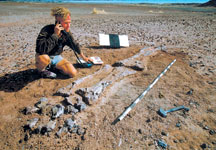What's happening in exploration
Remote communications and some discoveriesAt the OTC show, two communications firms caught my attention. The first is the (in)famous Iridium. In case you missed it last fall, the way-ahead-of-its-time, $5-billion, 66-satellite network was purchased from the bankruptcy court for less than a penny on the dollar. The low purchase price – together with a recent agreement with SAIT Communications S.A. – allows the company to provide a much smaller satellite handset with service at a greatly reduced cost, compared to the last Iridium incarnation. Companies with remote upstream operations might want to re-examine the "new" company. The other company, COMSAT Mobile Communications, was recently used for Project Exploration, a nonprofit organization whose goal is to make scientific discoveries accessible to the public and students. During fall 2000, a 14-person research team, led by world-renowned paleontologist Dr. Paul Sereno, journeyed to the barren Sahara Desert of Niger, Africa, to conduct a 16-weeklong expedition. The expedition was sponsored by the National Geographic Society and the David and Lucille Packard Foundation.
The expedition was searching for new dinosaur species and discovered nearly a dozen, including fish, turtles, crocodiles and a bizarre plant-eating dinosaur with 600 teeth. The team used a laptop-size Thrane and Thrane ISDN satellite telephone that weighs less than 12 lb. The ISDN service allowed high-speed data satellite links from four different Sahara camps while visiting over 300 dinosaur sites. Online access to discoveries was provided as they happened in the field and sent to www.projectexploration.org and www.nationalgeographic.org/dinoquest websites (see photo). More than 1,500 e-mails, 500 photographs and some video were sent and received. In April 2001, the project moved to the Gobi Desert in Inner Mongolia, China, for a similar "live" expedition. Parallel uses for our industry are obvious. Impressive discoveries. ExxonMobil subsidiary, Esso Exploration Angola Ltd., has made its 11th deepwater oil discovery on Block 15 since 1998. The Vicango-1 discovery, drilled in 3,199-ft-deep water to a 6,890-ft TD, is located about 200 mi northwest of Luanda, Angola. Block 15 has a reserve potential in excess of 3.5 billion boe. Planning for multiple developments is underway, with the first due onstream in 2004. In addition to Esso (operator, 40% interest), other Block 15 participants are BP Exploration Angola (26.67%), Agip Angola Exploration B.V. (20%) and Statoil (13.33%). Including Block 15, ExxonMobil subsidiaries have participated in 25 deepwater discoveries offshore West Africa. BP and Shell made two further oil discoveries in deepwater Block 18 offshore Angola. Although they were made in the fall of 2000, they are only now being announced. Since they were drilled near four existing discoveries, the wells enhance confidence in reserves estimates. The recent wells – Cromio, completed in October 2000, and Cobalto, completed in December 2000 – were drilled by the deepwater drillship Pride Angola. Including these latest wells, BP and Shell have found oil in all six wells drilled to date in Block 18. The wells lie within a 12.5-mi radius, collectively forming the Greater Plutonio Prospect, an area of 4,000 – 4,600 ft water depths that lies about 110 mi offshore. Block 18 was awarded in 1996 to Amoco Angola B.V. and Shell Development Angola B.V., each with 50% equity. BP announced a major deepwater discovery at its Aspen field in Green Canyon Block 243 in the Gulf of Mexico, about 150 mi south-southwest of New Orleans. The well was drilled in 3,000 ft of water by the semisubmersible Ocean Victory and encountered 490 ft of pay. Development plans are being evaluated. BP owns 80% of the block, with Nexen Petroleum USA owning the remainder. Block 243 is located near BP-operated Troika field. A discovery in the Sutu Den prospect in Viet Nam’s Cuu Long basin, Block 15-1, was initially estimated to contain 250 million bbl of oil reserves. However, appraisal SD-2X was tested in May and the results have increased the reserves estimate to 400 million bbl. SD-2X tested 4,809 bopd, but Korea National Oil Corp. (KNOC) predicted that it might produce as much as 12,000 bopd. The initial discovery occurred last September, when the Black Lion IX tested at 5,600 bopd. A second appraisal well will further define reserves and determine development plans. KNOC has a 14.25% stake in the consortium, with partners PetroVietnam, Conoco, SK Corp. and Geopetrol. Halliburton gets the Magic. The acquisition
combines Landmark Graphic’s integrated suite of E&P software with Magic Earth’s innovative 3-D
visual interpretation and data-mining technology and services. The agreement, subject to various regulatory
and other approvals, calls for a $100-million stock-for-stock transaction. The acquisition is not expected to
dilute earnings in 2001, and is expected to add to them next year. Magic Earth will become a wholly owned
subsidiary of Halliburton, operating as a separate business unit. Michael J. Zeitlin will remain president and
CEO of Magic Earth.
|
- Applying ultra-deep LWD resistivity technology successfully in a SAGD operation (May 2019)
- Adoption of wireless intelligent completions advances (May 2019)
- Majors double down as takeaway crunch eases (April 2019)
- What’s new in well logging and formation evaluation (April 2019)
- Qualification of a 20,000-psi subsea BOP: A collaborative approach (February 2019)
- ConocoPhillips’ Greg Leveille sees rapid trajectory of technical advancement continuing (February 2019)




